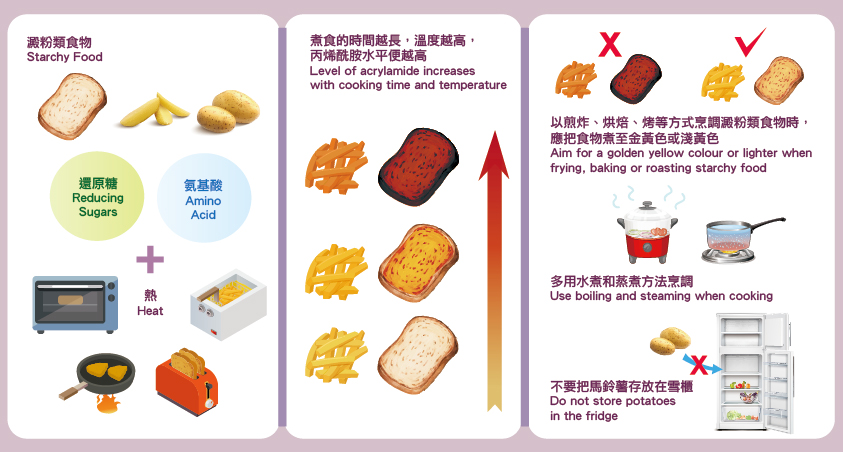
Food Safety Focus (185th Issue, December 2021) – Article 1
Process Contaminants in Food – Should I be Concerned?
Reported by Ms. Iris CHEUNG, Scientific Officer,
Risk Assessment Section, Centre for Food Safety
We cook foods to make them safe, likewise tastier, to eat. However, undesirable chemical by-products, known as process contaminants, can be formed unintentionally during home cooking or manufacturing. Acrylamide, glycidyl esters (GE) and 3-monochloropropane-1,2-diol esters (3-MCPDE) are the process contaminants that have recently been discussed in a report. While these substances may have potential health effects, there are ways that members of the public and the trade can reduce their content in food.
Acrylamide
Acrylamide is mainly formed in starchy foods, such as potatoes and bread, cooked under high temperatures as a result of the Millard reaction. It is a chemical reaction between the naturally present free amino acid asparagine and reducing sugars, such as glucose and fructose, in food when they are cooked or processed at 120°C or above. In general, more acrylamide will be formed under higher cooking temperature and longer cooking time. Many baked and fried foods like biscuits, chips, French fries and toast contain relatively high levels of acrylamide, whereas boiling and steaming do not typically form acrylamide.

Figure 1: Left: Formation of acrylamide; Middle: Level of acrylamide increases with increasing cooking time and temperature; Right: Ways to reduce acrylamide formation
Following ingestion, acrylamide is absorbed and distributed to all organs for metabolism. Animal experiments revealed that acrylamide may cause reproductive and developmental problems, and is associated with increased risk of developing cancers. As such, intake of acrylamide from our diet should be maintained as low as possible.
In general, acrylamide can be reduced by not cooking food at high temperatures for too long. When frying, baking, toasting or roasting starchy foods like potato and bread at home, consumers should aim for a golden yellow colour or lighter. Storing potatoes intended for frying and baking, etc. in fridge is not advisable as more reducing sugars will be formed, facilitating acrylamide formation during subsequent cooking. Furthermore, blanching vegetables before stir-frying or cooking them by boiling or steaming can also help reduce the formation of acrylamide. As starchy foods are key to our everyday diet, it is probably impractical to completely avoid acrylamide in food. Consumers should have a healthy and balanced diet and eat plenty of fruits and vegetables.
All along the trade is advised to seek ways to reduce the level of acrylamide in food. The trade may refer to the CFS’“Trade Guidelines on Reducing Acrylamide in Food” and the Codex’s “Code of Practice for the Reduction of Acrylamide in Foods” on reduction in acrylamide level during the selection of raw materials and the formulation of recipes and food processing conditions.
GE and 3-MCPDE
GE and 3-MCPDE are process contaminants that are formed when oils are heated at temperatures of about 160°C or higher to remove undesirable taste and odour during industrial refining. They are found in edible oils (e.g. vegetable oils) and foods containing these oils (e.g. biscuits, French fries and margarine). In particular, palm oil and its related food products are found to contain higher levels of GE and 3-MCPDE.
The potential health concern about GE and 3-MCPDE involves the release of glycidol and 3-monochloropropane-1,2-diol (3-MCPD) upon digestion. Research animal studies showed that glycidol is gene-damaging, whereas 3-MCPD may affect kidney and male reproductive system of rats. Their intake from our diet should also be maintained as low as possible.
Measures such as selection of raw materials with lower levels of GE and 3-MCPDE and reducing the amount of edible oil used in food production can reduce the level of GE and 3-MCPDE in food. The trade should make reference to Codex’s “Code of Practices for the Reduction of 3-MCPDEs and GEs in Refined Oils and Food Products Made with Refined Oils” and select the techniques that are appropriate to their processes and products.
Key Points to Note
- Acrylamide, GE and 3-MCPDE are process contaminants formed unintentionally in some foods that are cooked at high temperatures.
- The level of process contaminants should be kept as low as possible. Both consumers and the trade should make effort to reduce their levels in food.
Advice to the Public
- Do not cook food at high temperatures for too long. Cook by boiling or steaming can help reduce the formation of acrylamide. When handling prepackaged food, follow the manufacturer's cooking instructions to avoid overcooking.
- Reduce the consumption of refined fats and oils and related products (e.g. margarine) to reduce the exposure to GE and 3-MCPDE.
- Maintain a balanced and varied diet to minimise the risk from exposure to contaminants from a limited range of food items.
Advices to Trade
- Effort should be made to reduce the level of process contaminants in food products as low as practically possible.
- Adopt appropriate measures with reference to the CFS’ trade guidelines and relevant Code of Practices developed by the Codex.

